|
|
Railroad Paper
In the course of their operations, railroads issued an enormous amount
of paper items of various kinds, and just about all of these are of interest
to collectors. Of course like any other collectible, scarcity is a main
determinant of value, so some items that were produced in small quantities
-- like passes -- have more value than common items such as bills of
lading. Also, paper items from obscure but popular railroads such as
the Colorado narrow gauge lines command more attention than similar items
from the larger, more well-known companies. Lately it seems that paper
collectibles have come into their own with impressive auction prices
being realized for older public timetables and passes. However, all things
considered, paper still represents a good entry point to railroadiana-collecting
since many items are still obtainable for reasonable prices.
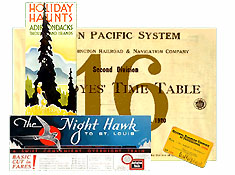 Railroad paper was produced for four basic audiences: investors, the
public, shippers, and employees. Investors were the first audience for
the obvious reason that money had to be raised for construction. However,
this rapidly changed to the traveling public and shippers in order to
raise revenues. When the majority of ordinary people traveled by rail,
a great deal of advertising was aimed at enticing travelers to choose
a particular railroad, route, or vacation destination. In the first decades
of the twentieth century, travel promotion reached a high art form with
specially commissioned illustrations and artwork. Today much of this
art, in the form of posters, public timetable covers, luggage stickers,
and other items, are especially prized by collectors. At one time, the
prevalent philosophy among railroad management was that an attractive
passenger service led to increased business in freight traffic, so passenger
business promotion was also considered an aid to the freight business.
However, there were special paper items aimed at shippers and companies,
most notably maps that illustrated the obvious convenience of a particular
route. In terms of quantity, probably the most paper generated by railroads
was for the benefit of internal operations, for example, employee timetables,
train orders, rule books, and other operational documents. Railroad paper was produced for four basic audiences: investors, the
public, shippers, and employees. Investors were the first audience for
the obvious reason that money had to be raised for construction. However,
this rapidly changed to the traveling public and shippers in order to
raise revenues. When the majority of ordinary people traveled by rail,
a great deal of advertising was aimed at enticing travelers to choose
a particular railroad, route, or vacation destination. In the first decades
of the twentieth century, travel promotion reached a high art form with
specially commissioned illustrations and artwork. Today much of this
art, in the form of posters, public timetable covers, luggage stickers,
and other items, are especially prized by collectors. At one time, the
prevalent philosophy among railroad management was that an attractive
passenger service led to increased business in freight traffic, so passenger
business promotion was also considered an aid to the freight business.
However, there were special paper items aimed at shippers and companies,
most notably maps that illustrated the obvious convenience of a particular
route. In terms of quantity, probably the most paper generated by railroads
was for the benefit of internal operations, for example, employee timetables,
train orders, rule books, and other operational documents.
The variety of railroad paper is almost unlimited, but there are a number
of popular categories that receive most of the collector interest in
this area. Without any claims to be comprehensive, here is a brief overview
of some of them:
 Annual
Reports. These documents were produced primarily for stockholders
and investors and, therefore, are sometimes overlooked as the specialty
of economic historians. However, a wealth of information regarding
operations and equipment can be obtained from such reports in addition
to financial matters. Generally, annual reports were no-nonsense documents
meant to convey financial solidity and propriety rather excitement.
Usually they have plain covers, although starting around the 1950's,
railroads started issuing annual reports with flashier cover designs
and pictures in the interior. Many early annual reports contained attractive
maps that were elaborate documents in their own right. In fact, many
railroad maps that show up in today's market were originally published
in the back of annual reports. Right: An 1893 Annual
Report from the Chicago, Milwaukee & St. Paul Railway, with a typical
plain cover. Annual
Reports. These documents were produced primarily for stockholders
and investors and, therefore, are sometimes overlooked as the specialty
of economic historians. However, a wealth of information regarding
operations and equipment can be obtained from such reports in addition
to financial matters. Generally, annual reports were no-nonsense documents
meant to convey financial solidity and propriety rather excitement.
Usually they have plain covers, although starting around the 1950's,
railroads started issuing annual reports with flashier cover designs
and pictures in the interior. Many early annual reports contained attractive
maps that were elaborate documents in their own right. In fact, many
railroad maps that show up in today's market were originally published
in the back of annual reports. Right: An 1893 Annual
Report from the Chicago, Milwaukee & St. Paul Railway, with a typical
plain cover.
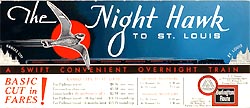 Blotters. Before
the advent of ball-point pens and when fountain pens were the dominant
writing instrument, an inexpensive and effective promotional item was
the blotter. Typically about 4 by 8 inches in size, blotters were used
to promote freight or passenger service and frequently provided information
on specific trains or routes. They could be quite colorful and often
featured special artwork. Right: A blotter advertising the "Night
Hawk", an overnight train between St. Louis and Kansas City operated
by the Burlington (Chicago, Burlington & Quincy Railroad and the
Alton Railroad, date unknown. Blotters. Before
the advent of ball-point pens and when fountain pens were the dominant
writing instrument, an inexpensive and effective promotional item was
the blotter. Typically about 4 by 8 inches in size, blotters were used
to promote freight or passenger service and frequently provided information
on specific trains or routes. They could be quite colorful and often
featured special artwork. Right: A blotter advertising the "Night
Hawk", an overnight train between St. Louis and Kansas City operated
by the Burlington (Chicago, Burlington & Quincy Railroad and the
Alton Railroad, date unknown.
 Calendars. At
one time, it was common practice for railroads to issue an annual calendar
as a promotional item. In the first half of the 20th Century, calendars
were usually illustrated with specially commissioned art, some of it
achieving great acclaim and artistic recognition. Probably the two most
famous series in this regard were Winold Reiss' magnificent portraits
of Blackfeet Indians which graced the calendars of the Great Northern
Railway over roughly two decades, and the paintings of Grif Teller which
depicted dramatic industrial scenes along the Pennsylvania Railroad.
By the early 1960's as passenger traffic dwindled to the point of no
return, most railroads dropped the annual calendar as a promotional device,
although a few railroads, notably Norfolk Southern and Union Pacific
have continued the practice to the present day. Today those early 20th
Century calendars that have survived are eagerly sought by collectors,
with special emphasis placed on completeness (full calendar pads) and,
of course, good condition. Right: A 1938 wall calendar from the Chicago,
Burlington & Quincy Railroad, A.K.A. the "Burlington". Calendars. At
one time, it was common practice for railroads to issue an annual calendar
as a promotional item. In the first half of the 20th Century, calendars
were usually illustrated with specially commissioned art, some of it
achieving great acclaim and artistic recognition. Probably the two most
famous series in this regard were Winold Reiss' magnificent portraits
of Blackfeet Indians which graced the calendars of the Great Northern
Railway over roughly two decades, and the paintings of Grif Teller which
depicted dramatic industrial scenes along the Pennsylvania Railroad.
By the early 1960's as passenger traffic dwindled to the point of no
return, most railroads dropped the annual calendar as a promotional device,
although a few railroads, notably Norfolk Southern and Union Pacific
have continued the practice to the present day. Today those early 20th
Century calendars that have survived are eagerly sought by collectors,
with special emphasis placed on completeness (full calendar pads) and,
of course, good condition. Right: A 1938 wall calendar from the Chicago,
Burlington & Quincy Railroad, A.K.A. the "Burlington".
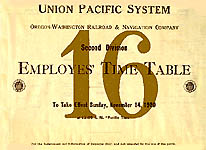 Employee
Timetables. Railroads have always issued timetables for the exclusive
use of their employees, a practice that continues to this day. Typically
such timetables provide information on physical plant, tonnage ratings
of locomotives, special conditions along the line, schedules of regular
trains, and other information of vital interest to railroad operation.
Probably no other single document gives such a telling picture of a
railroad's operation in a particular time period. In appearance, employee
timetables tend to be plain, no-nonsense booklets. Early examples were
often large in size (roughly 8 inches by 14 inches), and these are
sometimes referred to as "horseblanket" style. Gradually
railroads switched to the standard "timetable size" variety
(4" by 8"), although this transition did not occur all at
once. According to Tom Greco, Eastern roads were the first to do so,
with Midwestern and Western roads generally making the switch in the
1930's and 1940's. However, one railroad, the Canadian Pacific Railway,
used the large size until 1967. In recent years, many employee timetables
have been issued in binders. Right: A "horseblanket style" employee
timetable from the Oregon, Washington Railroad & Navigation Company,
a subsidiary of the Union Pacific system from November 14, 1920. Employee
Timetables. Railroads have always issued timetables for the exclusive
use of their employees, a practice that continues to this day. Typically
such timetables provide information on physical plant, tonnage ratings
of locomotives, special conditions along the line, schedules of regular
trains, and other information of vital interest to railroad operation.
Probably no other single document gives such a telling picture of a
railroad's operation in a particular time period. In appearance, employee
timetables tend to be plain, no-nonsense booklets. Early examples were
often large in size (roughly 8 inches by 14 inches), and these are
sometimes referred to as "horseblanket" style. Gradually
railroads switched to the standard "timetable size" variety
(4" by 8"), although this transition did not occur all at
once. According to Tom Greco, Eastern roads were the first to do so,
with Midwestern and Western roads generally making the switch in the
1930's and 1940's. However, one railroad, the Canadian Pacific Railway,
used the large size until 1967. In recent years, many employee timetables
have been issued in binders. Right: A "horseblanket style" employee
timetable from the Oregon, Washington Railroad & Navigation Company,
a subsidiary of the Union Pacific system from November 14, 1920.
 Luggage
Stickers. A seemingly lost practice among transportation providers
is the issuance of colorful luggage stickers to place on suitcases
and trunks. Railroads did this at one time, and many of these were
vivid and colorful. Right: A luggage sticker from the Chicago, Milwaukee,
St. Paul & Pacific Railway advertising its premier "Olympian" passenger
train to the Pacific Northwest. Luggage
Stickers. A seemingly lost practice among transportation providers
is the issuance of colorful luggage stickers to place on suitcases
and trunks. Railroads did this at one time, and many of these were
vivid and colorful. Right: A luggage sticker from the Chicago, Milwaukee,
St. Paul & Pacific Railway advertising its premier "Olympian" passenger
train to the Pacific Northwest.
Maps. Since railroad construction literally put many towns and
place names on the map, it is natural that railroads would take a leading
role in issuing maps of their territory. As mentioned above, many early
maps were produced in association with materials aimed at investors;
however, gradually they were seen as a means of 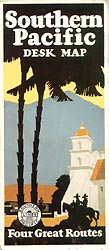 promoting
both passenger and freight business. There were essentially two variations
here: the folding map and the wall map. The former could be quite large
when unfolded but was printed on fairly light-weight paper and folded
into a timetable size document for storage. In contrast the wall map
was printed on heavier weight material and designed to be displayed rather
than folded. Old photos of railroad business offices frequently show
a wall map prominently displayed, and not uncommonly, the map is from
another railroad! Regardless of whether it was a folding map or wall
map, the railroad's lines would be shown in the context of the entire
country or, less commonly, only in the portion of the country where the
railroad operated. The railroad's own lines were always highlighted prominently,
while competitors' lines were faint by comparison. Also the lines would
often appear to be more direct (straighter) than they actually were,
obliterating, for example, a jog that the line actually took to avoid
a mountain range. This was, of course, intended to convince a shipper
that the route was in fact a "straight shot" and therefore
the best choice for a shipment. Map collecting is a hobby in its own
right, and since many early domestic maps were railroad-originated, there
is little wonder that fine, early railroad maps command serious interest
($$). Right: A desk map folded "timetable size" and issued
by the Southern Pacific Railroad in the late 1920's. The "Four Great
Routes" refer to the "Sunset Route" between New Orleans
and San Francisco, the "Overland Route" between Chicago and
San Francisco, the "Shasta Route" between San Francisco and
Portland, and the "Golden State Route" between Chicago and
Southern California. promoting
both passenger and freight business. There were essentially two variations
here: the folding map and the wall map. The former could be quite large
when unfolded but was printed on fairly light-weight paper and folded
into a timetable size document for storage. In contrast the wall map
was printed on heavier weight material and designed to be displayed rather
than folded. Old photos of railroad business offices frequently show
a wall map prominently displayed, and not uncommonly, the map is from
another railroad! Regardless of whether it was a folding map or wall
map, the railroad's lines would be shown in the context of the entire
country or, less commonly, only in the portion of the country where the
railroad operated. The railroad's own lines were always highlighted prominently,
while competitors' lines were faint by comparison. Also the lines would
often appear to be more direct (straighter) than they actually were,
obliterating, for example, a jog that the line actually took to avoid
a mountain range. This was, of course, intended to convince a shipper
that the route was in fact a "straight shot" and therefore
the best choice for a shipment. Map collecting is a hobby in its own
right, and since many early domestic maps were railroad-originated, there
is little wonder that fine, early railroad maps command serious interest
($$). Right: A desk map folded "timetable size" and issued
by the Southern Pacific Railroad in the late 1920's. The "Four Great
Routes" refer to the "Sunset Route" between New Orleans
and San Francisco, the "Overland Route" between Chicago and
San Francisco, the "Shasta Route" between San Francisco and
Portland, and the "Golden State Route" between Chicago and
Southern California.
 Menus. To
compete for business in the heyday of passenger train travel, railroads
operated first class food service in their dining cars. These were literally
restaurants on wheels, complete with special china, silverware, linens,
and, of course, menus. To examine such menus from our vantage point in
time is to be impressed by the type of food that could be freshly prepared
in a rocking dining car kitchen little bigger than a closet. Also impressive
are the low prices, although these naturally have to be judged in light
of the pay scales of the day. Many railroad menus were produced with
beautiful covers, sometimes customized for special charter groups. Early
examples often featured illustrations and artwork on their covers, while
later examples (from the1950's on) tended to use photographs. Right:
A menu from the Canadian Pacific Railway dating from the late 1920's
and featuring a beautiful cover on the Maple Sugar Industry. This menu
lists a broiled half chicken for $1.25 and a sirloin steak for $1.50. Menus. To
compete for business in the heyday of passenger train travel, railroads
operated first class food service in their dining cars. These were literally
restaurants on wheels, complete with special china, silverware, linens,
and, of course, menus. To examine such menus from our vantage point in
time is to be impressed by the type of food that could be freshly prepared
in a rocking dining car kitchen little bigger than a closet. Also impressive
are the low prices, although these naturally have to be judged in light
of the pay scales of the day. Many railroad menus were produced with
beautiful covers, sometimes customized for special charter groups. Early
examples often featured illustrations and artwork on their covers, while
later examples (from the1950's on) tended to use photographs. Right:
A menu from the Canadian Pacific Railway dating from the late 1920's
and featuring a beautiful cover on the Maple Sugar Industry. This menu
lists a broiled half chicken for $1.25 and a sirloin steak for $1.50.
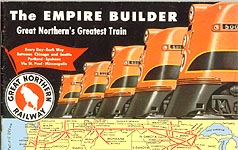 Name
Train Brochures. When railroads instituted a new train, particularly
one with a special name, they often produced brochures to announce
the event. This was especially true during the "last hurrah" of
private passenger train innovation -- in the late 1940's and early
1950's when many railroads rolled out postwar streamliners in an effort
to revive the passenger train business. From observation, the name
train brochures produced during this period show some of the finest
commercial illustration and design quality of any category of railroad
paper. Because of their relatively new vintage, these brochures have
tended to be rather inexpensive until recently when collectors have
begun to recognize their esthetic value. Right: A name train brochure
from the Great Northern Railway introducing its new, streamlined "Empire
Builder" in 1949. Name
Train Brochures. When railroads instituted a new train, particularly
one with a special name, they often produced brochures to announce
the event. This was especially true during the "last hurrah" of
private passenger train innovation -- in the late 1940's and early
1950's when many railroads rolled out postwar streamliners in an effort
to revive the passenger train business. From observation, the name
train brochures produced during this period show some of the finest
commercial illustration and design quality of any category of railroad
paper. Because of their relatively new vintage, these brochures have
tended to be rather inexpensive until recently when collectors have
begun to recognize their esthetic value. Right: A name train brochure
from the Great Northern Railway introducing its new, streamlined "Empire
Builder" in 1949.
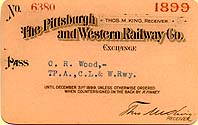 Passes. From
the very beginning of the industry, railroads occasionally needed to
provide free transportation to individuals. For example, officials of
other roads were sometimes given a tour of the lines, prospective shippers
were invited to examine facilities before agreeing to contracts; employees
needed to be transported to a work site, and so forth. The mechanism
for regulating such free transportation was the pass. Typically a pass
took the form of a small piece of cardstock, about the size of a modern
credit card with dimensions that allowed them to fit in a wallet. Passes
can be found from extremely early and obscure railroads, including those
that had little or no passenger service. In this respect, passes represent
one of the few tangible remnants from many long-gone lines. Right: An
1899 pass from the Pittsburgh & Western Railway. Passes. From
the very beginning of the industry, railroads occasionally needed to
provide free transportation to individuals. For example, officials of
other roads were sometimes given a tour of the lines, prospective shippers
were invited to examine facilities before agreeing to contracts; employees
needed to be transported to a work site, and so forth. The mechanism
for regulating such free transportation was the pass. Typically a pass
took the form of a small piece of cardstock, about the size of a modern
credit card with dimensions that allowed them to fit in a wallet. Passes
can be found from extremely early and obscure railroads, including those
that had little or no passenger service. In this respect, passes represent
one of the few tangible remnants from many long-gone lines. Right: An
1899 pass from the Pittsburgh & Western Railway.
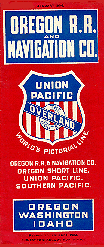 Public
Timetables. Passenger train or "public" timetables can
be found in a variety of forms, from plain, single-sheet schedules
describing service by a single railroad to large, poster-size schedules
(called "broadsides") that typically describe all the arrivals
and departures of one station. Most common are "timetable size" (4" by
8") booklets issued by a single railroad covering all passenger
trains operated by that company for a given time period. Like employee
timetables, passenger timetables offer a fascinating insight into railroad
operations during a given historical period. All timetables provided
arrival and departure times for specific trains, but many also provided
information on equipment assignments (number of coaches, sleeping cars,
etc.), fares, travel advice, and route descriptions. Some were rather
plain and utilitarian in design while others were quite colorful with
ornate cover art. The collection and study of passenger timetables
constitutes a specialty within the hobby, and there is even an organization
devoted exclusively to this activity. Right: An January, 1904 public
timetable from the Oregon Railroad and Navigation Company. By this
time in history, the O.R. & N. Co. had become affiliated with the
Union Pacific System, hence the latter's "Overland Shield" logo
on the cover. Public
Timetables. Passenger train or "public" timetables can
be found in a variety of forms, from plain, single-sheet schedules
describing service by a single railroad to large, poster-size schedules
(called "broadsides") that typically describe all the arrivals
and departures of one station. Most common are "timetable size" (4" by
8") booklets issued by a single railroad covering all passenger
trains operated by that company for a given time period. Like employee
timetables, passenger timetables offer a fascinating insight into railroad
operations during a given historical period. All timetables provided
arrival and departure times for specific trains, but many also provided
information on equipment assignments (number of coaches, sleeping cars,
etc.), fares, travel advice, and route descriptions. Some were rather
plain and utilitarian in design while others were quite colorful with
ornate cover art. The collection and study of passenger timetables
constitutes a specialty within the hobby, and there is even an organization
devoted exclusively to this activity. Right: An January, 1904 public
timetable from the Oregon Railroad and Navigation Company. By this
time in history, the O.R. & N. Co. had become affiliated with the
Union Pacific System, hence the latter's "Overland Shield" logo
on the cover.
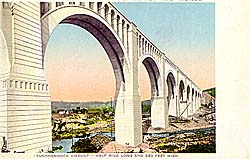 Postcards. In
the early part of the twentieth century, when railroads were at their
zenith as passenger transportation, a immense number of postcards were
produced of railroad scenes. Typically these were used as a means of
communication when traveling or sightseeing. Specific subjects included
railroad stations, scenic rights-of-way, rolling stock, railroad engineering
landmarks, and even wrecks. Railroad postcards are fascinating today
because they provide a glimpse of a different era of travel, and many
show scenes that are long vanished. Right: A postcard
of Delaware, Lackawanna & Western Railroad's Tunkhannock Viaduct
shortly after it was built around 1915. This landmark still exists and
is in use. Postcards. In
the early part of the twentieth century, when railroads were at their
zenith as passenger transportation, a immense number of postcards were
produced of railroad scenes. Typically these were used as a means of
communication when traveling or sightseeing. Specific subjects included
railroad stations, scenic rights-of-way, rolling stock, railroad engineering
landmarks, and even wrecks. Railroad postcards are fascinating today
because they provide a glimpse of a different era of travel, and many
show scenes that are long vanished. Right: A postcard
of Delaware, Lackawanna & Western Railroad's Tunkhannock Viaduct
shortly after it was built around 1915. This landmark still exists and
is in use.
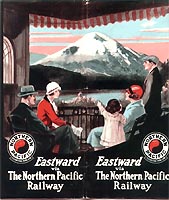 Route
Guides. Railroads met their passengers' interest in the route they
were traveling with guides that described points of interest along
the way. In some instances, there were separate versions of these guides
for each direction (East and West or North and South). For the most
part, such guides were produced only by those lines that traveled appreciable
distances through areas known for scenic beauty, both in the East and
West. They are particularly interesting nowadays in describing cities
and localities as they existed a half century or more ago. Right:
An "Eastward" route guide produced by the Northern Pacific
Railway. It dates from the 1920's. Route
Guides. Railroads met their passengers' interest in the route they
were traveling with guides that described points of interest along
the way. In some instances, there were separate versions of these guides
for each direction (East and West or North and South). For the most
part, such guides were produced only by those lines that traveled appreciable
distances through areas known for scenic beauty, both in the East and
West. They are particularly interesting nowadays in describing cities
and localities as they existed a half century or more ago. Right:
An "Eastward" route guide produced by the Northern Pacific
Railway. It dates from the 1920's.
 Rulebooks. Railroads
typically published a wide range of little booklets for employees covering
rules, regulations, tariffs, union agreements, and other necessary operational
information. These are almost always pocket-sized, about 3" by 5" and
usually have plain, brown covers. Illustrations in these booklets are
minimal, usually consisting of signal indications and other simply drawn
diagrams. In the case of rule books, however, their plainness was no
indication of importance. Since all operating employees had to pass rules
exams, these books were intensely scrutinized, and it is not uncommon
to find surviving books that are especially worn and full of notations. Right:
A rule book from the Western Maryland Railway dated 1915 and entitled "Rules
and Instructions Governing Free Travel and Passes." The contents
of this book are presented separately on this website. Rulebooks. Railroads
typically published a wide range of little booklets for employees covering
rules, regulations, tariffs, union agreements, and other necessary operational
information. These are almost always pocket-sized, about 3" by 5" and
usually have plain, brown covers. Illustrations in these booklets are
minimal, usually consisting of signal indications and other simply drawn
diagrams. In the case of rule books, however, their plainness was no
indication of importance. Since all operating employees had to pass rules
exams, these books were intensely scrutinized, and it is not uncommon
to find surviving books that are especially worn and full of notations. Right:
A rule book from the Western Maryland Railway dated 1915 and entitled "Rules
and Instructions Governing Free Travel and Passes." The contents
of this book are presented separately on this website.
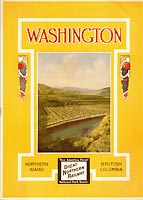 Settlement
Publications. Publications that were designed to entice settlement
rather than just travel were common in the early days of railroad construction,
most particularly in the West. The Western U.S. and Canadian transcontinental
lines were built through remote territory that had little on-line business
or population, so one of the main efforts of early railroad builders
was to promote settlement along their lines. Accordingly, they produced
booklets of statistics and information related to farming, ranching,
and other livelihoods to be distributed both domestically and abroad
to prospective settlers. Of course, the general tone of these publications
was one of future success and prosperity, and undoubtedly more than
one settler discovered that the picture presented was a little too
rosy! Right: A 1914 settlement booklet from the Great Northern
Railway describing the benefits of taking up residence in the state
of Washington and province of British Columbia. The booklet was part
of a series of booklets providing "accurate information for the
land-hungry." Settlement
Publications. Publications that were designed to entice settlement
rather than just travel were common in the early days of railroad construction,
most particularly in the West. The Western U.S. and Canadian transcontinental
lines were built through remote territory that had little on-line business
or population, so one of the main efforts of early railroad builders
was to promote settlement along their lines. Accordingly, they produced
booklets of statistics and information related to farming, ranching,
and other livelihoods to be distributed both domestically and abroad
to prospective settlers. Of course, the general tone of these publications
was one of future success and prosperity, and undoubtedly more than
one settler discovered that the picture presented was a little too
rosy! Right: A 1914 settlement booklet from the Great Northern
Railway describing the benefits of taking up residence in the state
of Washington and province of British Columbia. The booklet was part
of a series of booklets providing "accurate information for the
land-hungry."
 Tickets
and Ticket Folders. Tickets for passenger train travel were issued
in the millions but good examples are not necessarily that common.
After all, they were of temporary value and most were collected and
destroyed. How many of us save the remnants of our airline tickets?
In addition to the tickets themselves, the ticket envelopes that accompanied
them are also very collectible, especially those that are colorful
or illustrated. Right: A ticket issued by the Baltimore & Ohio
Railroad for a trip from Washington, PA. to Wheeling, WV on a special
college excursion train, Saturday, June 17th, 1911. Tickets
and Ticket Folders. Tickets for passenger train travel were issued
in the millions but good examples are not necessarily that common.
After all, they were of temporary value and most were collected and
destroyed. How many of us save the remnants of our airline tickets?
In addition to the tickets themselves, the ticket envelopes that accompanied
them are also very collectible, especially those that are colorful
or illustrated. Right: A ticket issued by the Baltimore & Ohio
Railroad for a trip from Washington, PA. to Wheeling, WV on a special
college excursion train, Saturday, June 17th, 1911.
 Travel
Brochures. To promote vacation travel, railroads issued attractive
booklets describing the qualities of destination points served by their
lines. In fact, specific railroads became strongly associated in the
public mind with particular geographic localities, for example, the
Great Northern Railway with Glacier Park, the Atchison, Topeka & Santa
Fe Railway with the Grand Canyon, and the New York Central Railroad
with the Adirondack Mountains and Hudson River Valley. Because these
brochures were usually aimed at the leisure traveler, attractiveness
was critical. Covers were often illustrated with special artwork, and
interiors usually contained enticing drawings or photographs as well
as richly evocative descriptions. Today these brochures describe a
view of travel that is notably different from the contemporary emphasis
on thrills and theme destinations. While not ignoring exciting activities,
they seem to put more emphasis on serenity, relaxation, the subtleties
of nature, and a strong sense of place. Nostalgia for a different,
seemingly lost approach to travel is a major side effects of reading
these brochures. Right: A brochure by the New York Central
Railroad describing the beauties of the Adirondack Mountains, Thousand
Islands area, and Saratoga Springs. It dates from the late 1920's. Travel
Brochures. To promote vacation travel, railroads issued attractive
booklets describing the qualities of destination points served by their
lines. In fact, specific railroads became strongly associated in the
public mind with particular geographic localities, for example, the
Great Northern Railway with Glacier Park, the Atchison, Topeka & Santa
Fe Railway with the Grand Canyon, and the New York Central Railroad
with the Adirondack Mountains and Hudson River Valley. Because these
brochures were usually aimed at the leisure traveler, attractiveness
was critical. Covers were often illustrated with special artwork, and
interiors usually contained enticing drawings or photographs as well
as richly evocative descriptions. Today these brochures describe a
view of travel that is notably different from the contemporary emphasis
on thrills and theme destinations. While not ignoring exciting activities,
they seem to put more emphasis on serenity, relaxation, the subtleties
of nature, and a strong sense of place. Nostalgia for a different,
seemingly lost approach to travel is a major side effects of reading
these brochures. Right: A brochure by the New York Central
Railroad describing the beauties of the Adirondack Mountains, Thousand
Islands area, and Saratoga Springs. It dates from the late 1920's.
Summary. The categories of railroad paper discussed here are
by no means exhaustive. Some additional categories of railroad-originated
paper are employee magazines, recipe booklets issued by railroad dining
care departments, stock certificates, and informational booklets describing
facilities such as yards. To these can be added the enormous variety
of forms - train orders, bills of lading, dispatcher sheets etc., --
that were used in day-to-day operations as well as business documents
such as correspondence and letters. But wait...there's more. Documents
issued by some railroad suppliers and manufacturers, for example catalogs
from Baldwin Locomotive Works or Adams & Westlake, makers of lanterns
and railroad hardware, are generally considered railroad paper. So the
list is almost endless.
The good news is that much railroad paper is still relatively inexpensive
compared to hardware such as lanterns. In addition, there is much history
in this paper -- not necessarily the grand history of corporations but
rather the history of day-to-day life as it was experienced by travelers,
employees, and anyone else who had some contact with the railroads. Probably
no other category of railroad collectible offers such a rich potential
for new information.
Notes
Further Reading: Only one book has been published
on the general topic of railroad paper, although other books have discussed
it in the context of general railroadiana. That one book is by Brad Lomazzi's Railroad
Timetables, Travel Brochures & Posters, published in 1995
by Golden Hill Press, Spencertown, NY 12165. In addition, Carlos
Schwantes' Railroad Signatures Across the Pacific Northwest, published
by the University of Washington Press in 1991, has an extensive discussion
of the use of printed materials by railroads in this region as well as
some beautifully reproduced examples. |